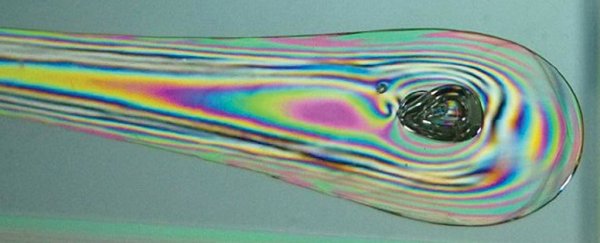Don't let the fact that the objects known as Prince Rupert's drops are made out of glass fool you – the pretty, tear-drop shaped baubles can withstand some pretty harsh punishment. Until you gently snap their tail, at least.
New research has literally shed a light on the drops' odd balance of incredible strength and fragility, revealing it all comes down to a thin skin of glass held under incredible tension.
A team of researchers led by scientists from the US and UK used a beam of polarised light to measure the internal properties of the glass drops to show how a tough outer skin and the channelling of cracks make for a paradoxical object that is as tough as it is brittle.
Prince Rupert's drops are relatively simple to make; they're little more than molten glass dropped into cold water, creating a solid blob with a long, thin tail.
Smacking the fat end with a hammer, pressing it with up to 20 tons of force, or even shooting it with a gun won't do it a lot of damage.
To break it, however, you only need to tap its tail, which will cause the entire object to disintegrate into a shower of tiny shards.
There aren't any records on the drops' origins, but sometime around 1660 Prince Rupert of the Rhine reportedly gave a number of 'glass bubbles' to King Charles II of England as gifts, who passed them on to the Royal Society of London to conduct a few studies of their own.
The drops' remarkable properties were put down to the rapid cooling of the outer surface of the glass, forming a hard shell that allowed the insides to cool and then contract a little slower.
It was this difference in layers – the 'squeezing' (or compressive forces) of the outer layer and the 'pulling' (or tensile forces) of the core – that was thought to explain both its toughness and fragile tail.
New toys in the laboratory have allowed physicists over time to find new ways to test Prince Rupert's drops, and in 1994 materials scientists Srinivasan Chandrasekar from Purdue University and M. Munawar Chaudhri from the University of Cambridge in the UK did what any of us would do with a high speed camera and a glass object – watch it shatter.
Their research added more detail to the traditional explanation – breaking the tail appears to send a line of cracks running down the length of the drop at speeds of up to 1,900 m/s (6,200ft/s), with the crack-front slowing down as it enters the surface layer.
They also measured the toughness and size of the surface layer, finding it extended about 15 percent of the way into their experiment's drops and had a compressive stress of 90 to 170 MPa (about 13,000 to 25,000 psi).
In this latest experiment, the researchers put the drop under a different set of tests and recalculated their previous estimates, discovering in the process that the secret to Prince Rupert's drop lies in more than just the toughness of its extraordinary skin.
This time the scientists lowered a drop into a liquid with the same refractive index as the glass.
Shining a polarised beam of red light through the liquid and the drop caused the light's rays to distort slightly inside the glass, revealing even more details about its characteristics.
The process showed much higher compressive stresses in the surface of the glass drops, of around 525 MPa (76,000 psi) in the head and a whopping 700 MPa (102,000 psi) in the tail.
They also determined the surface layer to be about 10 percent of the diameter of the drop's head.
This high compressive stress in the thin outer layer of the glass drops goes some way to explain why they can withstand such enormous forces, however there's one more piece of the puzzle.
Based on their past experiments and their investigation using polarised light, the team found that any cracks that did form in the surface layer tended to run parallel to the core.
"In order for a PRD [Prince Rupert's drop] to disintegrate catastrophically, it is necessary for any cracks, induced by the compression process, to enter the tension zone in the head of the PRD," the researchers explained in their report.
That's why they're so easy to break at the tail end. Once a crack gets through the compressed skin into the zone that's held under tension, it's game over.
If only the curious mob of Royal Society scholars had such fancy equipment sitting around 400 years ago, they might have nailed the secrets behind Prince Rupert's Drops much sooner.
"I believe we have now solved most of the main aspects of this area. However, new questions may emerge unexpectedly," Chaudhri told Lisa Zyga at Phys.org.
Let's hope so – future scientists could use an excuse to break a few glass baubles themselves.
This research was published in Applied Physics Letters.
